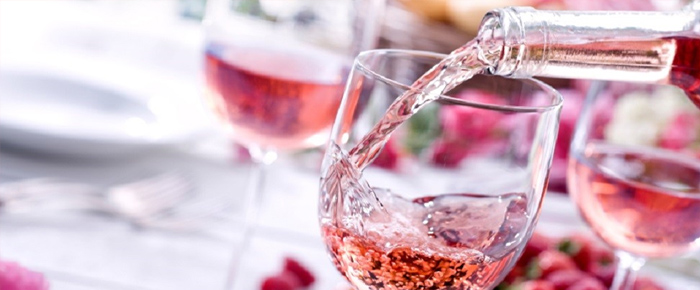
By Rick Riozza
Rosé in the morning, rosé in the evening, rosé at supper time—be my little rosé, and love me all the time…♬
See!—this is what happens when a wine columnist stays out too long in the noonday sun; and I’m not even an Englishman. At least I’m enjoying a…well—you guessed it, a refreshing and tasty rosé wine.
We’ve written often on how dry rosé wines, either still or sparkling, are the vino ticket for any occasion, any meal, and especially to succor us desert dwellers to endure the full day sun and sustain the sultry nights. Rosé’s quality continues on the rise, and this fresh, fruity but dry wine is the perfect quaff for our evanescent spring and the increasing summertime season throughout the world.
The Provence region in the south of France has always been the hotbed for Rosé—it’s famous for it! And the Europeans have long embraced this wonderful wine for consumption as the weather warms and more dining is done al fresco. A temperate day, a bucket of ice, a bottle of Rosé, and life is good.
As to America, it’s been said, “Pink wine has traveled a wobbly road. “ At times it’s been all the rage. Other times, it’s simply been ignored. And until recently—it was kinda like the underdog of the wine world. But now, excellent dry rosés are produced throughout the vineyard biosphere.
I just read in the New York Times, “If you love wine and care about what you drink, you can raise your rosé game by seeking out wines that are made with integrity and care. They cost more, yes, but what you get are wines that not only dazzle and refresh, but also welcome contemplation, if you’re in the mood. You would not want to serve these in plastic cups at a lawn party, but they would be perfect with an outdoor dinner. Your cookout guests may even do double-takes before asking for another glass.”
I’m currently enjoying an array of rosé—indeed, each one listed below deserves an entire article itself on the wine and the producing winery. And we’ll get to that during the season. For now, let’s do some quick introductions on some quaffs I’m heartily recommending:
2015 Truvée Rosé, $15: In a previous column, “McBride Sisters have found it! Truvée Wines!”(Dec. 10 2015), we reviewed their Red Blend and Chardonnay. Now they are producing a rosé, in the southern Rhone tradition of blending Grenache and Syrah.
You’ll remember the two sisters who grew up, unbeknownst to each other, on two different continents, only to find each other and each other’s talent for making wine: Such a great story.
Robed in some pretty sunset colors, this wine is tasty and refreshing. The nose shows strawberry, raspberry, and nuanced floral aromas and continues onto the palate with wild berry and Meyer lemon. It’s dry, crisp with very good acidity to match most meals.
2014 SAVED “Magic Maker” Rosé, $16: This crisp California wine from celebrity tattoo artist Scott Campbell and legendary winemaker Clay Brock (Wild Horse Vineyards) is a really fun wine to enjoy. It’s pale pink and bone dry and midway between a white and a red as to body and feel.
It owns alluring aromas of white peach, and tasting notes of tangerine, strawberries and green apple—a really interesting composite for a “pink wine”. Made in a Provençal-style with the winemakers stating, “it’s a refresher that’s perfect for everyone, including guys (who aren’t afraid to drink pink anymore).”
The intricate label, Scott’s design, (whose symbols include a coded message to his wife, Lake Bell) offers an affordable way for readers to get a piece of his in-demand art.
2015 Willamette Valley Vineyards Rosé of Pinot Noir, $24: An astonishing number of Pacific Northwest wineries are now making rosés — and Oregon’s Willamette Valley is making some of the region’s best. Willamette Valley Vineyards, using the region’s signature Pinot Noir, makes one of the most expressive and enthralling.
This is the rosé that one brings to a dinner party. A stately color of copper and salmon, it reeks elegance atop the table. It is vibrant with complexity; and maintains beautiful flavors of strawberry, nectarine, honeysuckle with a touch of vanilla. It has a wonderful finish of watermelon and raspberry.
This rosé is entirely estate grown from their LIVE certified sustainable vineyards. All of you Pinot Noir fans will fall in love with this one!
On the European side of things:
2015 Le Rosé de Mouton Cadet, $13: Everyone is familiar with this brand of easy quaffing inexpensive Bordeaux—both the red and the white. As we’ve reported, everyone is jumping on the rosé band wagon—so why not Mouton Cadet as well. And when was the last time you enjoyed a Bordeaux Rosé? Exactly!
Le Rosé is a blend of traditional Bordeaux varieties: Merlot (53%) gives roundness and fruit, Cabernet Franc (20%) brings refinement and Cabernet Sauvignon (27%) the power and the structure typical of Bordeaux.
A glittering pale pink wine with a very fresh nose that opens with red currant, raspberry, and pink grapefruit aromas—some herby notes as well. The palate continues with the same and also shines with strawberry and cherry notes.
2015 Guigal Côtes du Rhône Rosé, $15: The Guigal family has made serious rosé wines since the 1940s. Their Côtes du Rhône Rosé, like all their Côtes du Rhône wines, is first class. The blend is made up of Grenache (60%), Cinsault (30%), and Syrah (10%).
This expressive dry rosé displays bowls of red fruits, raspberry, red currant and strawberry in particular, along with floral and citrus notes, and finally hints of savory Provencal herbs. A seductive, complex and flat out delicious wine!
Next time: Sparkling Rosés—Cheers!












































